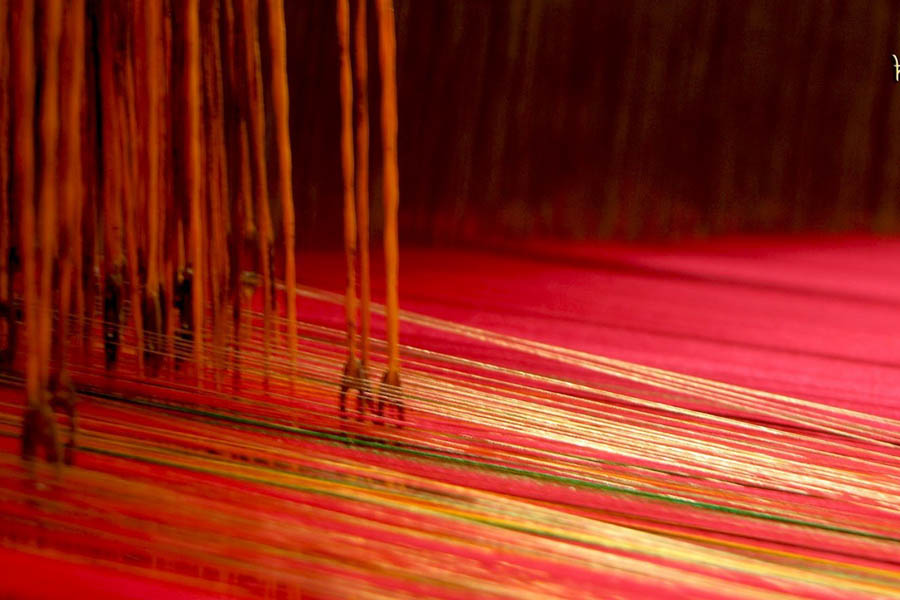The Number Story
The saree-like drape dates back to as early as 100 B.C. Over thousands of years, this versatile garment has evolved beautifully while retaining its place as one of the most cherished forms of attire among Indian women. Whether crafted in pure silk, cotton, silk-cotton, tussar, or raw silk, the saree continues to symbolize grace, culture, and heritage. Today, women across India proudly drape sarees for every joyous moment.
Behind this timeless garment lies a fascinating world of numbers — numbers that represent the astonishing scale and artistry of India’s saree-weaving tradition.
Let’s unravel some of these extraordinary facts.
What Is a Saree?
A saree is an unstitched length of cloth measuring:
- Width: 42–49 inches
- Length: 5.5 to 9 yards
Many traditional drapes, including classic silks like those in our Six Yards Saree Collection, follow this measurement.
The Saree Styles
India boasts 20+ traditional saree draping styles, each rooted in regional culture.
Some iconic ones include:
- Kerala set-mundu
- Coorgi drape
- Gujarati pallu
- Maharashtrian nauvari
- Bengali atpoure
- Andhra’s kacchanivi
This diversity reflects India’s cultural richness, weaving heritage, and regional identity.
The Cost Factor
Sarees range from ₹200 to ₹20 lakh, depending on:
- Fabric
- Weave
- Design
- Texture
- Workmanship
- Brand
Nearly 50% of the cost of a handloom saree is for raw material alone.
Explore luxurious weaves in our Silk Saree Collection.
The People Behind the Weave
India’s saree story is incomplete without honouring the weavers.
- Over 43 lakh people work in the handloom sector, second only to agriculture.
- The Banaras weaving industry employs over 5 lakh people, with an annual trade value exceeding ₹5,000 crore.
- In Kanchipuram alone, 5,000+ families are directly involved in weaving traditional silk sarees.
For exquisite craftsmanship, explore Handwoven Kanjivaram Silk Sarees.
The Process
Weaving a saree is an intense numerical and physical journey:
- A typical saree takes 8 hours to weave.
- The average saree weighs 850–900 grams.
- Over a career of 30 years, a weaver makes 18,360,000 limb movements to complete around 1,000 sarees.
Time required for famous sarees:
- Kanjivaram - about 1 week
- Maheshwari - 3 days
- Banarasi - 4 days (intricate pieces can take 6 months)
Three artisans often work together to weave one authentic Banarasi saree.
The Mathematics of Kanjivaram
(The Pride of Tamil Nadu)
Kanchipuram — home to the legendary Kanjivaram silk — holds extraordinary weaving statistics:
- 20,000+ looms
- 5 lakh+ sarees produced annually
- 3–6 artisans working on a single saree
- Warping frame includes 60 holes
- 240 warp threads and 250–3000 weft threads
A weaver uses his legs 17,920 times to weave a single Kanjivaram saree.
Kanjivaram silk is also known for:
- 57% silver and 0.6% gold in authentic Zari (as per GI standards)
- Width of a saree: 48 inches (broader than the usual 45")
- Weight: 500 g – 1 kg
Traditional Kanjivarams originally measured nine yards, but practical six-yard drapes are popular today.
To explore stunning options, browse:
- Gold Kanjivaram Silk Sarees
- Silver Kanjivaram Silk Sarees
- Tissue Kanjivaram Sarees
- Small Border Kanjivaram Sarees
The Beautiful Truth
The next time you drape this exquisite garment, take a moment to appreciate:
- The mathematics
- The labour
- The artistry
- The physical endurance
- The generational knowledge
- The soul of the weaver
A saree is not just fabric, it is a masterpiece shaped by body, mind and tradition.
The people behind the scene:
- Any story on sarees is incomplete without the mention of the weavers, who form an integral part of the textile industry in the country. With over 43 lakh people involved in weaving and allied activities, the handloom sector is second only to agriculture in terms of employment.
- The Banaras saree weaving industry provides employment to over 5 lakh people in Varanasi district alone and the trade is valued at over Rs 5,000 crore per year.
- In Kanchipuram , over 5,000 families are engaged in saree weaving.
The process
- Generally, a saree takes about 8 hours of weaving from start to finish. The average weight of the saree is 850-900 grams.
- During a weaving career spanning 30 years, a weaver uses his limbs 18,360,000 times to weave about 1,000 sarees!
- A Kanjivaram silk saree takes about a week to finish, while a Maheswari takes about 3 days.
- A Banarasi saree takes about 4 days, with some sarees extending to 6 months, depending on the intricacy of the pattern! Three people work together to weave one Banarasi saree.
The magic of Kanjivaram
- Kanchipuram in Tamil Nadu, which is famous for the Kanjivaram silk sarees, has more than 20,000 looms and produces more than 5 lakh sarees a year. Three to four weavers work in each loom. Some handloom varieties require at least 6 workers for a single saree.
- The warping frame used to weave this fabric has about 60 holes. There are 240 threads in the warp and 250 to 3000 threads in the weft. This is how complex and mathematical the weaving process is!
- In addition to this, there is a tremendous physical effort involved in weaving a Kanjivaram saree. There are 10,000 single-ply silk threads in the warp. The average number of wefts per inch is 70 and 17,920 in a saree. This means a weaver uses his legs 17,920 times to weave 1 saree!
- As per Geographical Indication (GI) label, a Kanjivaram saree should have 57% silver and 0.6% gold in the Zari. Thus, an authentic Kanjivaram with pure silk and pure zari can cost anywhere between Rs. 7,000 and Rs.2,00,000.
- The width of a regular saree is 45 inches but a Kanjivaram silk saree is around 48 inches. A typical Kanjivaram saree weighs between 500 grams and 1 kg. It was initially a nine-yard weave but over the years the more practical six-yard has become popular.
So, the next time you drape this beautiful garment, do remember and appreciate the intricate computation behind the weaving of the saree and the labour of the body, mind and soul.




